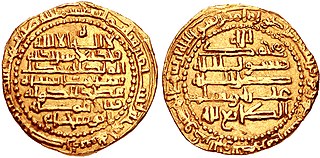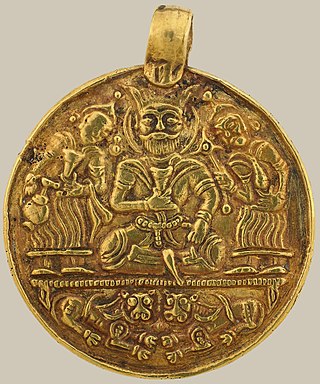
The Buyid dynasty, also spelled Buwayhid, was a Zaydi and, later, Twelver Shia dynasty of Daylamite origin, which mainly ruled over central and southern Iran and Iraq from 934 to 1062. Coupled with the rise of other Iranian dynasties in the region, the approximate century of Buyid rule represents the period in Iranian history sometimes called the Iranian Intermezzo.

Abu’l-Qāsim ʿAbdallāh ibn ʿAlī ibn Aḥmad ibn Ṭalḥa ibn Jaʿfar ibn Muḥammad ibn Hārūn al-Mustakfī bi’llāh , better known by his regnal name al-Mustakfī bi’llāh was the Abbasid caliph in Baghdad from 944 to 946.

Abū ʾl-Qāsim al-Faḍl ibn al-Muqtadir, better known by his regnal name of al-Mutīʿ li-ʾllāh, was the Abbasid caliph in Baghdad from 946 to 974, ruling under the tutelage of the Buyid emirs.

Abu Bakr ʿAbd al-Karīm ibn al-Faḍl, better known by his regnal name al-Ṭāʾiʿ liʾllāh/biʾllāh, was the Abbasid caliph of Baghdad from 974 to his deposition in 991. He was in office during the domination of Iraq by the Shi'a Buyid dynasty, and as a result is generally considered a powerless figurehead under the thumb of the Buyid emirs. His tenure was also marked by strife between rival Buyid rulers and the frequent change of hands of Baghdad: al-Ta'i' himself was raised to the throne by a rebel Turkic general, Sabuktakin, who deposed al-Ta'i's father, al-Muti'. During periods of such strife, al-Ta'i' was able to exert some measure of political independence, but under stronger rulers he was sidelined, and was obliged to marry the daughters of the emirs Izz al-Dawla and Adud al-Dawla. Al-Ta'i's status suffered under Adud al-Dawla in particular, who turned to pre-Islamic Persian models for legitimacy, and relegated Iraq to the status of a simple province ruled from Fars. Al-Ta'i' was deposed on 22 November 991 by Baha al-Dawla, and replaced with his cousin, al-Qadir. He spent the rest of his days, until his death in 1003, confined to the caliphal palace.

The Ziyarid dynasty was an Iranian dynasty of Gilaki origin that ruled Tabaristan from 931 to 1090 during the Iranian Intermezzo period. The empire rose to prominence during the leadership of Mardavij. After his death, his brother Vushmgir and his Samanid allies led the dynasty in wrestling for control over territory against the Buyids in the early- to mid-10th century. When Vushmgir died, his sons Bisutun and Qabus fought for influence. Qabus would eventually outlive his brother and ruled the kingdom. However, Qabus was placed in exile from 980 to 998 by the Buyid ruler, Adud al-Dawla who would then dominate Tabaristan, the heartland of Ziyarid power. A succession of other rulers came to rule the kingdom with Ghaznavid support in the early 11th century. The Nizari Ismaili state invaded and ended Ziyarid rule in 1090.

Bakhtiyar, better known by his laqab of Izz al-Dawla, was the Buyid amir of Iraq (967–978).

Ahmad ibn Buya, after 945 better known by his laqab of Mu'izz al-Dawla, was the first of the Buyid emirs of Iraq, ruling from 945 until his death.
Abu'l-Hasan Ali ibn al-Hasan, better known by his laqab of Fakhr al-Dawla was the Buyid amir of Jibal, Hamadan (984–997) and Gurgan and Tabaristan (984–997). He was the second son of Rukn al-Dawla.

Hasan, better known by his laqab as Rukn al-Dawla, was the first Buyid amir of northern and central Iran. He was the son of Buya.

Ali ibn Buya, commonly known by his laqabImad al-Dawla, was the founder of the Buyid amirate of Fars, ruling as its amir (ruler) from 934 to 949. Together with his two younger brothers, Rukn al-Dawla and Mu'izz al-Dawla, he established a triumvirate, centered on Ray, Shiraz and Baghdad.

Abu Mansur Buya, better known by his honorific title of Mu'ayyad al-Dawla was the Buyid amir of Hamadan (976–983), Jibal (977–983), Tabaristan (980–983), and Gorgan (981–983). He was the third son of Rukn al-Dawla.

The Kakuyids were a Shia Muslim dynasty of Daylamite origin that held power in western Persia, Jibal and Kurdistan. They later became atabegs (governors) of Yazd, Isfahan and Abarkuh from c. 1051 to 1141. They were related to the Buyids.

Fannā (Panāh) Khusraw, better known by his laqab of ʿAḍud al-Dawla was an emir of the Buyid dynasty, ruling from 949 to 983, and at his height of power ruling an empire stretching from Makran to Yemen and the shores of the Mediterranean Sea. He is widely regarded as the greatest monarch of the dynasty, and by the end of his reign he was the most powerful ruler in the Middle East.
The Arabic title al-Dawla means 'dynasty' or 'polity', and appears in many honorific and regnal titles in the Islamic world. Invented in the 10th century for senior statesmen of the Abbasid Caliphate, such titles soon spread throughout the Islamic world and provided the model for a broad variety of similar titles with other elements, such as al-Din.
Abu 'l-Fadl Muhammad ibn Abi Abdallah al-Husayn ibn Muhammad al-Katib, commonly known after his father as Ibn al-'Amid was a Persian statesman who served as the vizier of the Buyid ruler Rukn al-Dawla for thirty years, from 940 until his death in 970. His son, Abu'l-Fath Ali ibn Muhammad, also called Ibn al-'Amid, succeeded him in his office.
The office of amir al-umara, variously rendered in English as emir of emirs, prince of princes,chief emir, and commander of commanders, was a senior military position in the 10th-century Abbasid Caliphate, whose holders in the decade after 936 came to supersede the civilian bureaucracy under the vizier and become effective regents, relegating the Abbasid caliphs to a purely ceremonial role. The office then formed the basis for the Buyid control over the Abbasid caliphs and over Iraq until the mid-11th century.

Muhammad ibn Rustam Dushmanziyar, also known by his laqab of Ala al-Dawla Muhammad, was a Daylamite military commander who founded in 1008 the short-lived but important independent Kakuyid dynasty in Jibal. He is also known as Pusar-i Kaku, Ibn Kakuyeh, Ibn Kakuya, and Ibn Kaku, which means maternal uncle in the Deylami language, and is related to the Persian word "kaka". Muhammad died in September 1041 after having carved out a powerful kingdom which included western Persia and Jibal. However, these gains were quickly lost under his successors.
Abu Mansur Muhammad ibn 'Abd al-Razzaq ibn 'Abdallah ibn Farrukh, also simply known as Abu Mansur Muhammad and Ibn 'Abd al-Razzaq, was an Iranian aristocrat who served the Samanids during the most of career, and briefly served as governor of Azerbaijan under the Buyids.
Mansur ibn Qara-Tegin, commonly known after his father as Ibn Qaratakin was a Turkic military officer of the Samanids in the mid-10th century.
Abu Ishaq Ibrahim, also known by his honorific title of Umdat al-Dawla, was a Buyid prince, who was the youngest son of the Buyid ruler Mu'izz al-Dawla.












